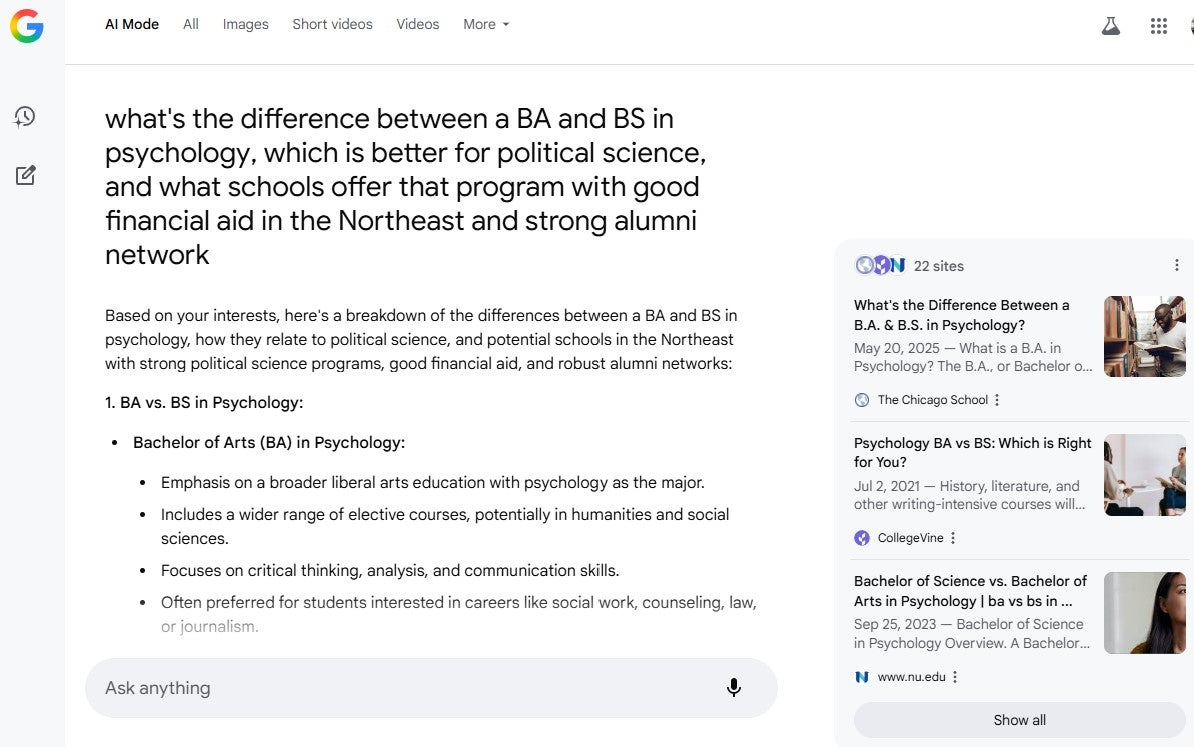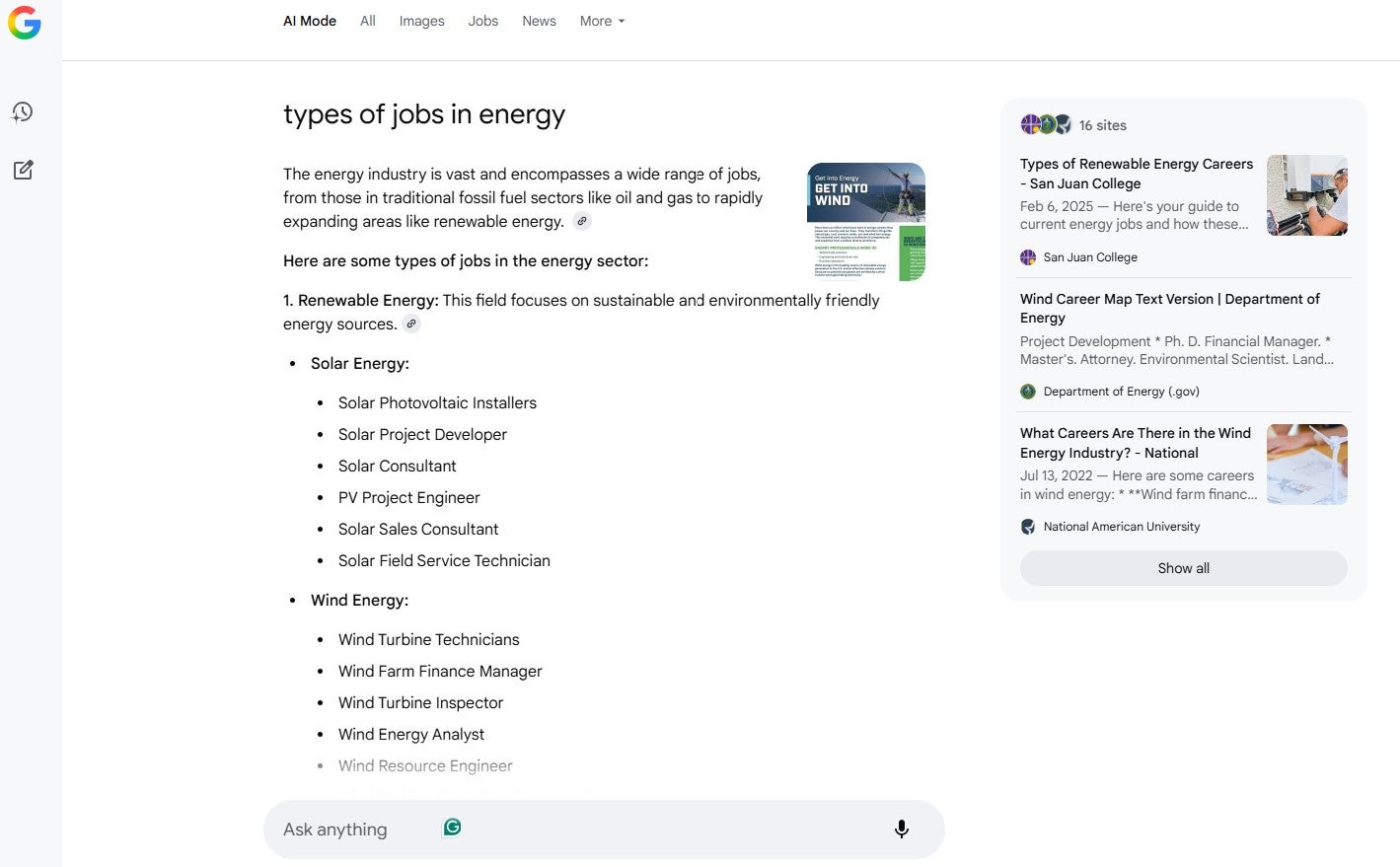 Jul 22, 2025
Persona
Jul 22, 2025
Persona
One constant in the higher education marketing landscape is prospective students’ online search for information. While everything else seems to be in flux, higher education marketers who stay attuned to the relentless pace of artificial intelligence (AI)-powered search engines and large language models (LLMs) will be able to ensure their institutions’ content and brand remain visible and impactful, regardless of where or how users search the web.
For more than two years, we’ve navigated the implications of AI Overviews and generative search engines, adapting our strategies with what we’ve learned. But just as we were unpacking that terrain, Google is ushering in the next significant evolution: Google AI Mode. Today, we will explore what this means for students and colleges, and how building your website on a foundation of content tailored to meet a complete user journey is essential for your institution’s search engine optimization (SEO) efforts, as well as your PPC (Pay-Per-Click) ad strategy.
What is Google AI Mode?
While you’re likely familiar with Google’s AI Overviews and their impact on Search Engine Results Pages (SERPs), on May 20, 2025, Google rolled out to all users a feature called AI Mode, a fully interactive chatbot-style interface powered by Google’s most advanced LLM, Gemini 2.5, and live web search. This will move search from simple summaries and ten blue links (so last decade) to a deeply interactive experience, acting like a personal research assistant.

Building on AI Overviews, AI Mode understands even more complex, multi-part questions and creates detailed reports on the spot. Visually, its placement as a prominent tab on the main Google search page on both desktop and mobile provides a clear, separate space for these deeper, more conversational search chains.
Like other generative search engines like ChatGPT’s search function and Perplexity, AI Mode is designed for questions beyond a simple keyword search. For queries too complex or unique to yield the traditional ten blue links, AI Mode can provide a synthesized answer that replaces the conventional search results and includes links to its sources for further exploration. This encourages users to engage more deeply with follow-up questions, making it the perfect environment for the complex student journey.
Deep Search in AI Mode
A function in the AI Mode rollout called “Deep Search” enables the user to request the system perform complex tasks, such as comparing two programs or two institutions, which require more time and thought. The system responds by generating a report over several minutes rather than providing an immediate answer.
AI Mode employs a query fan-out technique. It takes a complex request, breaks it into smaller parts, and performs dozens or hundreds of searches simultaneously. The result is a synthesized report contextualizing information from diverse sources.
Why AI Mode Demands a Strategic Shift
For higher education, Google AI Mode is a natural evolution from AI Overviews, as the conversational search trend reflects how prospective students in the AI era gather information while making significant life decisions.
With AI Mode, prospective students don’t have to limit their search for “psychology majors.” AI Mode is built for complex, multi-part, hyper-specific searches like: “What’s the difference between a BA and BS in psychology, which is better for law and political science, and which schools with one have good financial aid in the Northeast and a strong alumni network?”
The benefits of ensuring your brand’s visibility in AI Mode’s highly personalized, immersive search experience make the quality and structure of your website content even more crucial than ever for your university’s digital strategy. Organic visibility is critical, but don’t forget to maintain a strong paid search strategy as well. A seamless connection between your organic content and PPC messaging reinforces credibility and can guide high-intent users toward conversions.
Do Google’s AI Search Features Bring Higher Quality Clicks?
With AI-generated summaries in search results becoming prominent, you may worry about fewer prospective students clicking through to your website. However, early signs suggest something more positive. According to Search Engine Land, Google’s Liz Reid said search results with AI Overviews get higher quality clicks, and that searchers dig into their responses.
With this, even if the total number of clicks changes for pages cited in AI Mode, the quality of traffic from these features could be significantly higher. For colleges and universities, a “higher quality click” translates directly into more qualified prospective students entering your enrollment funnel. Someone clicking on a cited result in AI Mode isn’t just a casual browser; they are actively “digging in” to their research, making them potentially more likely to convert into inquiries or applications. Users exposed to your content in AI summaries may also later return through PPC ad clicks, often with higher intent and stronger conversion potential.

Optimizing for AI Mode and the Future of Agentic AI
AI Mode’s “deep search” features and Google’s new push into agentic AI (an AI that can take actions for users, like booking a flight) rely on web content that’s easy to find, answers questions, and guides users and AI crawlers to key information with clear, concise, and structured content with strong Expertise, Experience, Authority, and Trust (E-E-A-T).
If your institution has already learned strategies for optimizing AI Overviews, you’ve built a solid foundation. Now, with AI Mode, it’s time to elevate those efforts, refining and expanding existing SEO practices to make your website the definitive resource that AI systems confidently recommend and synthesize for AI search.
Here’s how to evolve your higher education SEO strategy for AI Mode:
1. Become the Definitive “Research Assistant” Source
AI Mode thrives on providing “full reports” by synthesizing information from multiple sources. For your content to feature prominently in these sophisticated AI-generated summaries, it must be seen as the ultimate answer to complex inquiries, anticipating not just the initial question but all potential follow-ups.
Strategy: Shift your content strategy from merely answering a query to providing an extensive, end-to-end guide on a specific topic, including all subtopics a prospective student, parent, or researcher might explore.
- Long-form, Evergreen Content: Create “ultimate guides” or in-depth resources, such as an “Ultimate Guide to Biology Degrees: Exploring Career Paths and Program Specializations.”
- Anticipate Multi-Part Questions: Structure all pages, including academic, admissions, and financial aid pages, to answer layers of questions proactively. If someone searches for “forensic psychology degree,” ensure your content covers all of the potential popular long-tail keywords and follow-ups, like “program curriculum,” “career outcomes,” etc.
- Build Topic Clusters: Focus content efforts around central themes to establish deep topical authority, signaling to AI your institution is the go-to expert for generative AI search in higher education.
2. Structure for AI Understanding
AI models analyze content structure to understand context, relationships, and hierarchy. To be effectively digested and utilized by AI Mode’s deep search capabilities, your content must be impeccably organized for both human and machine readability.
Strategy: Prioritize crystal-clear content organization using strong URL structure and logical navigation to help LLMs parse and categorize information for retrieval.
- Hierarchical Heading Structure: Ensure every content section and sub-section has a concise, descriptive heading (H2-H4) that accurately reflects its content. This acts as a roadmap for AI.
- Structured Data Formats: Structured data in a page’s JSON-LD script (where page type and elements are listed) helps AI agents and search engines understand content and identify certain information, such as a faculty member’s name. In this way, structured data helps Google and AI tools understand the page’s purpose and also better identify and present information to the user.
- Optimize Image and Video: For image galleries, virtual tours, and video content, ensure images have strategic, descriptive alt text and videos include accurate transcripts and keyword-rich descriptions.
3. Reinforce Your Institutional Authority
In the AI age, the credibility of cited sources becomes paramount. Google’s E-E-A-T guidelines are more crucial than ever because Google AI Mode will prioritize information from highly trustworthy and authoritative sources.
Strategy: Build and showcase your institution’s institutional authority, expertise, and trustworthiness across all digital touchpoints.
- Showcase Faculty Expertise: Ensure faculty profiles, research publications, and news articles highlight academic credentials, research breakthroughs, and real-world experience. Link directly to faculty bios from relevant program pages. (Read our faculty profiles guide!)
- Promote Accreditations & Awards: Display institutional accreditations, program-specific recognitions, and major awards on “About Us” pages, program overviews, and relevant landing pages.
- Transparent Sourcing and Quoting: When presenting data or research (even from within your institution), link to the full, trustworthy source. Add a “human touch” to content with real quotes from students, faculty, or stakeholders, complete with a picture, name, and profile link if available.
4. Refine Metrics of Success in the AI Era
While direct website clicks remain essential, the prominence of AI-generated summaries suggests a need to look beyond traditional page impressions and click-through rates. Google announced that AI Mode data (impressions and clicks) will be found in Google Search Console, but not separated from all organic traffic.
Strategy: Shift your focus from solely evaluating clicks to ensuring your institution is a consistently cited, authoritative source within AI-generated search experiences, influencing the impact of AI Mode on higher ed enrollment.
- Monitor Branded Searches: Track increases in branded searches in tools like Google Search Console. A rise here could indicate enhanced brand awareness driven by AI exposure. Consider a paid search remarketing strategy to reconnect with users who first encountered your institution via AI content, bridging the gap between AI-driven awareness and enrollment action.
- Analyze On-Site Engagement: Pay close attention to user behavior (e.g., deeper page views, lower bounce rates, increased time on site) for traffic referred from AI-driven snippets such as ChatGPT, and if data indicates a higher-quality lead.
- Qualitative Observation: While direct AI Mode performance data will initially be limited in Search Console, consistently review AI-generated answers for queries relevant to your institution to see if your content is referenced or summarized. Tools like SEMRush track AI Overview appearances to help inform your AI SEO metrics.
5. Prepare for the Multimodal Future of Search
Google AI Mode is natively multimodal, designed to process and present information from various formats. Like AI Overviews, pages with images such as a chart, infographic, or table will be cited in key areas of the chat interface. In the future, AI Mode may even assist users with tasks directly within search.
Strategy: Optimize all forms of media on your website and explore how you may structure data to enable future AI-driven actions.
- Multimodal Content Optimization: Double down on optimizing all media types. Ensure accurate transcripts and keyword-rich descriptions on YouTube and your website for videos. For images, use strategic, descriptive alt text and optimize file sizes.
- Embrace Search Experience Optimization: This holistic approach acknowledges that users engage with information in many ways. It encompasses optimizing not just for search rankings, but for the entire user journey—from initial search to on-site experience, regardless of whether a click happens. Read our guide on Search Experience Optimization.
- Anticipate Agentic Capabilities: While still emerging, the future of search in higher education could involve AI assisting with multi-step tasks directly in search. Imagine an AI helping a prospective student schedule a virtual campus tour directly from a search query, or pre-populating an inquiry form with personal information. This transition means ensuring your data is not just present, but structured and easily consumable for these advanced, multi-step actions, significantly impacting your AI-driven student engagement.
Optimizing Paid Search for AI Environments
AI Mode is fundamentally changing how users search, which in turn is shifting how PPC (Pay-Per-Click) advertisers should respond. Ads are currently live in AI Overviews, with placements in AI Mode expected soon. Marketers must evolve their strategies to align with this new search behavior and maintain strong performance and visibility.
To continue driving results and increase your chances of appearing in AI ad placements, we recommend that you:
- Maintain eligibility for AI ad placements: Broad match keywords, AI-driven Performance Max campaigns, and the new AI Max for Search feature all support visibility in AI-generated search results. While most ads currently appear for consumer products, establishing eligibility now positions you to capitalize as coverage expands across more verticals.
- Use broad match keywords strategically: Broad match keywords allow your ads to show on related intent; for example, the keyword “mba degree” might trigger searches like “how to become a ceo” or “best business schools.” This flexible match type can be especially effective for reaching the long-tail, conversational queries common in AI Mode and can increase your ad’s eligibility in AI environments.
- Strengthen the impact of your ads: As search becomes more visual, use image extensions to help your ads stand out within AI-influenced results. Align your messaging with the themes users see in your organic content to meet expectations shaped by AI summaries and answers.
- Design landing pages for speed and clarity: Ensure that landing pages load quickly, render well on all devices (don’t forget mobile!), and clearly distinguish your main content from navigation. Incorporate images and videos to reflect the multimodal nature of AI Mode.
- Adjust performance expectations: AI features can reduce the total number of ad impressions and clicks, but those who do see and click your ads may be deeper in the funnel and reflected in applications and enrollments. Refine campaigns to prioritize quality over quantity, emphasizing conversion-focused messaging and landing pages.
PPC isn’t going away, but it is evolving. Even before ads fully roll out in AI Mode, refining your keyword strategy and creative assets now will help ensure your institution stays visible and competitive in this shifting landscape.
Navigating Higher Ed’s Role in a Future of AI-Powered Search
With the advancement of Google AI Mode in web search, an effective higher education marketing, communications, and enrollment strategy will incorporate a robust SEO approach along with a strong paid component designed for AI visibility to ensure students and other audiences can research and learn about your institution.
Success in AI search results depends on adaptability and focusing on the user’s journey. The goal shifts from merely getting clicks to becoming a trusted, frequently referenced source of information within AI-generated responses. This, in turn, builds invaluable brand awareness, establishes your institution as a leader in its field, and ensures visibility in the tools users will find and explore web content.
We encourage higher ed marketers to proactively audit content for AI readiness, refine their organic and paid AI search strategies, and embrace a new era of AI search for universities. Early adoption offers a significant competitive advantage in attracting future students.
Start a conversation today to learn how our expert strategists can help your institution navigate these changes, future-proof your website with advanced AI search engine SEO and PPC strategies, and boost your online engagement to attract more prospective students.
